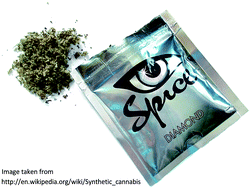Recreational drug discovery: natural products as lead structures for the synthesis of smart drugs
Abstract
Covering: up to December 2013.
Over the past decade, there has been a growing transition in recreational drugs from natural materials (marijuana, hashish, opium), natural products (morphine, cocaine), or their simple derivatives (heroin), to synthetic agents more potent than their natural prototypes, which are sometimes less harmful in the short term, or that combine properties from different classes of recreational prototypes. These agents have been named smart drugs, and have become popular both for personal consumption and for collective intoxication at rave parties. The reasons for this transition are varied, but are mainly regulatory and commercial. New analogues of known illegal intoxicants are invisible to most forensic detection techniques, while the alleged natural status and the lack of avert acute toxicity make them appealing to a wide range of users. On the other hand, the advent of the internet has made possible the quick dispersal of information among users and the on-line purchase of these agents and/or the precursors for their synthesis. Unlike their natural products chemotypes (ephedrine, mescaline, cathinone, psilocybin, THC), most new drugs of abuse are largely unfamiliar to the organic chemistry community as well as to health care providers. To raise awareness of the growing plague of smart drugs we have surveyed, in a medicinal chemistry fashion, their development from natural products leads, their current methods of production, and the role that clandestine home laboratories and underground chemists have played in the surge of popularity of these drugs.


 Please wait while we load your content...
Please wait while we load your content...